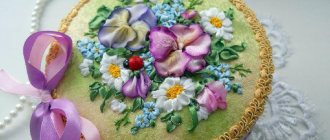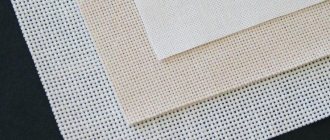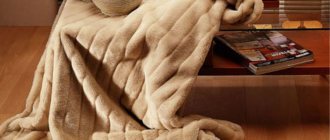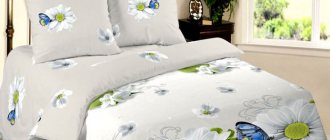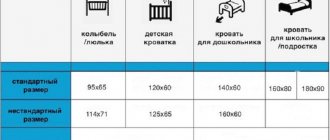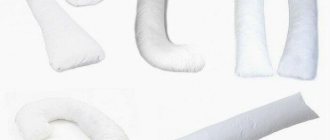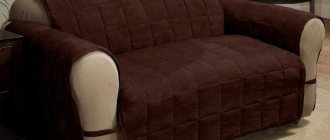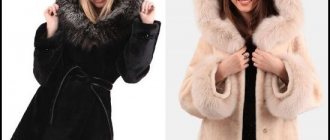Overlay and water-soluble canvas
But what if you wanted to decorate with cross stitch not a special fabric, but, for example, clothing? An overhead or water-soluble canvas will help you with this.
The overlay canvas is attached to any fabric using basting stitches, and after finishing the work, the marking and canvas threads are pulled out, and the design remains on the fabric. One of the disadvantages of the applied canvas is that when pulled out, the crosses can become deformed, and the embroidery will look sloppy. And it’s not always easy to pull out the tough threads of the canvas.
In Russia, the most popular and widespread water-soluble canvas is from Gamma. Before starting work, it is also basted to the future base for embroidery (it is recommended to do this with white thread, since after pulling it out from threads of a different color, colored fibers may remain). After finishing the work, the basting seams should be removed, and the embroidery should be placed in hot (40-50 degrees) soapy water and left for 10-15 minutes. This time is usually enough for the canvas to completely dissolve. After this, you need to rinse the product thoroughly.
5% discount
Canvas K06 45x45
Gamma, K06R 45x45 yellow
327 rub. 311 rub.
Add to cart
Choosing a canvas: different types and uses, plus a cheat sheet for calculating the number of crosses
What types of canvas are there: main types
Aida type canvas
Photo: cloudsfactory.net
Photo: wisegeek.com
The most famous and popular variety. In this type of canvas, the threads are intertwined in a special way, so as to form squares with holes in the corners, convenient for getting a needle into them (while it is more difficult to insert a needle into the dense center of the square, this helps to avoid mistakes). This canvas is very convenient for cross stitch, including for those who are just starting to learn this needlework.
Canvas of uniform weaving, or “uniform”
Photo: cloudsfactory.net
Photo: posiegetscozy.com
In a canvas of uniform weaving, the threads are intertwined in a classic way, but not too tightly - so that it is more convenient to count the crosses and get between the threads with a needle. “Uniform” canvas is often chosen by more experienced embroiderers: working with it requires more experience and a “trained” eye. Here you will have to “arrange” the crosses yourself (as a rule, these are 2 by 2 threads in length and width). But the result is more “lively” and realistic - especially if you use small canvas when embroidering a large pattern.
Stramin
Photo: leutenegger.com.au
Photo: youtube.com/DK Wright Construction
Stramin is a canvas characterized by increased rigidity. Stramin is similar to a rigid and sparse thread mesh. Most often used to create carpets and tapestries. Sometimes, due to its rigid structure, it can be used to make boxes or bags. More often, the size of the stramine cross is larger than that of other canvas, so they embroider on it with thicker threads (wool, acrylic). There is no need for a hoop or a machine here, the straightener holds its shape on its own. Craftsmen advise: to prevent the threads from clinging to the hard edges of the stramine while working, you should tie them with a hook with a thick soft thread or cover them with masking tape.
Plastic canvas
Photo: viorin.com
Photo: gingerbreadsnowflakes.com
Photo: pinterest.co.uk/sdooley13
This canvas looks like a rare plastic mesh and is distinguished by the fact that it holds its given shape well. It is plastic canvas that is good to use for volumetric or textured embroidery, for making souvenirs of various shapes. When cutting, the edges of such a canvas will not fray - so you can embroider and cut out any shapes (remembering the perfect reverse side of the work). This canvas is also used for making boxes, bags, and so on (sometimes it is sold in a form specifically specified for the manufacture of a particular product).
Overlay canvas
Photo: weelittlestitchescrossstitch.blogspot.com
This canvas is designed to embroider even crosses on any fabric you need. This canvas is applied to the fabric and basted. After the pattern is embroidered, the canvas is carefully pulled out one thread at a time, while the embroidery remains intact and unharmed. With such a canvas it is convenient to decorate various products with embroidery elements.
Dissolvable Canvas
Photo: essorille.livejournal.com
Invented not so long ago to replace the overhead pull-out canvas. Just like the previous version, this canvas is applied to the fabric, embroidery is done with its help, and then the finished work is soaked in warm water. Water dissolves the canvas and it disappears, but the design remains on the product.
Hand sewing needles: main types and purpose
What is canvas count
Photo: youtube.com/Carolyn Mazzeo
The canvas count is an important characteristic of it, expressing in a numerical value the size of the “cell” of the canvas. This characteristic is important because the size of each cross in your embroidery will depend on the value of the count, respectively, the thickness of the thread that is best used for embroidery, and, ultimately, the size of the finished work.
The count is determined, as a rule, by the letters ST and numbers before or after the letters. The relationship between the size of the cross and the count value is the opposite: that is, the higher the count number, the smaller the cross you will get on a given canvas. For example: a canvas with a count of 9 will produce larger crosses than a canvas with a count of 11. The size of the canvas can be different and is characterized by the number of cells in 1 inch.
Photo: thesprucecrafts.com
Different types of hoops: which ones to choose, how to use?
Cheat sheet: how many crosses are in the outline of different counts
Count of canvas "Aida": number of crosses in 10 cm
9 = 33 crosses
11 = 43 crosses
14 = 55 crosses
16 = 63 crosses
18 = 71 crosses
Count of "uniform" canvas: number of crosses (2 by 2 threads) per 10 cm
20 = 40 crosses
25 = 50 crosses
28 = 55 crosses
32 = 63 crosses
36 = 71 crosses
Traditional canvas
Traditional canvas is a rather rare fabric. Canvas for cross stitch and beadwork are divided into types according to the weaving method:
- linen weave;
- Stramin.
Linen weave canvas is a fabric in which the threads are arranged in pairs. There are quite large gaps between the pairs of warp and weft threads. It is these gaps that are used for punctures with a needle. The size of the canvas for bead or cross stitch is also determined by the number. For linen weave, there are sizes from 22 (large mesh) to 36 (small mesh).
Stramin is a dense canvas with large holes. Most of all, this canvas is suitable for embroidery with thick threads using the tapestry technique or with large beads. Stramin is not suitable for high-definition drawings - it is best to choose it for geometric patterns.
Selecting a canvas
So, we found out what kind of canvas there is for embroidery with beads and cross. This knowledge alone greatly simplifies the issue of choice. We now know that there is canvas for small and large embroidery. Meanwhile, there remains one more nuance: how the size of the canvas relates to the size of the cross or beads.
Let's start with how to choose a canvas for cross stitch. Everything is simple here: you just have to imagine what size crosses you are going to embroider, and choose a canvas with a square of exactly that size. Yes, it’s as simple as that: what size is the cross, what size is the cell of the canvas.
You can also read about cross stitch canvas in our article here.
Now let's look at how to choose a canvas for bead embroidery. Here everything is a little more complicated. Before purchasing, you should already have the beads you are going to embroider with. The cell size of the canvas should be slightly larger than the size of the bead, otherwise the embroidery will turn out ugly.
Types of canvas for cross stitch
If you ask a beginning embroiderer about the types of canvas, most likely she will name two: regular and with a printed pattern, which can be color or black and white. In fact, the variety of bases for embroidery is very large, because the differences can be in the material, color, and size of the cells.
Today, you can find many varieties in stores and on craft websites. The most popular brand is Aida. This variety is usually made from cotton, but sometimes mixed materials are used, mainly to make it more decorative. The advantages of Aida are a wide selection of sizes and ease of use. The needle easily fits into the holes, and the clear pattern allows you to avoid mistakes when transferring the design. It is no coincidence that it is with this canvas that beginners begin their acquaintance with cross stitching.
Experienced needlewomen often use uniform weave canvas as a basis for embroidery. It is a more complex type and is used by experienced craftswomen. It is more difficult to mark on it, and to make each cross you need to count two threads in the horizontal direction, and two more in the vertical direction. Its composition can be different:
- cotton;
- linen;
- consisting of cotton and synthetic threads.
This type of canvas is interesting because it can be used for paintings that partially fill the space. The canvas becomes a natural background for cross stitch, and the contrast between filled and unfilled fragments can emphasize the unusual nature of the work.
Stramin is used for cross stitching of pillows and small decorative rugs. It has very dense threads and large squares, so you should choose patterns without small details. Stramin is embroidered not with cotton, silk or acrylic, but, as a rule, with wool. The work looks voluminous and soft. It is very convenient to work with it, which is why many masters begin their creativity by using Stramin.
Plastic canvas can be used for decorative items. It is quite rigid, holds its shape well, so it is well suited for embroidered wall decorations, souvenirs using the technique of volumetric or figured embroidery. It is convenient to work with such a base, and the embroidery can be easily washed without fear that the design will be deformed. One of the interesting new products is water-soluble canvas. It is made from special threads and is used for cross stitching on clothing, bed linen and other made items. A drawing is sometimes applied to this base, which is convenient to navigate. When the product is ready, it is immersed in water and the auxiliary threads are completely dissolved. All that remains is to dry and iron the item. The base can have different colors: white, beige, black, red, yellow and any other. In ready-made sets, the color is often selected to match the overall gamut of the image. This creates an interesting effect, especially if the embroidery is loose.
Aida 16c blue (width 110 cm)
-70%
1 500 450
Aida 14c black (width 150 cm)
-70%
1 400 420
Features of material for embroidery with beads
The base for bead embroidery should have clearly visible cells and large holes for easy threading of the needle.
You might be interested in Features of embroidering icons and images with stones
Beadwork
These fabrics include 2 types of canvas:
- “Aida” canvas – you don’t have to use a hoop, and the stitches and beads on thick fabric will look even and beautiful. There is also a wide range of colors that can be matched to the tone of the embroidery, and different sizes.
- Fabric of uniform weave - threads of material of uneven thickness - this significantly affects the appearance of the finished product. The material is softer than Aida. The threads of the fabric are even.
Beads for embroidery must exactly match the size of the canvas so that the product does not curl and the fabric does not stretch.
Bead selection
To make the correct selection, you must use the table:
| Fabric number for embroidery | Bead number |
| 6 | 4 |
| 8 | 6 |
| 11 | 8 |
| 14 | 10 |
| 16 | 11 |
| 18 | 12 |
| 20 | 13 |
| 22 | 15 |
Note! It is worth embroidering pictures with high quality materials. Czech and Japanese beads are best.
